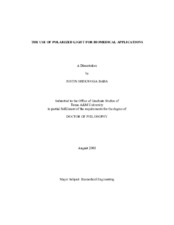| dc.description.abstract | Polarized light has the ability to increase the specificity of the investigation of biomedical samples and is finding greater utilization in the fields of medical diagnostics, sensing, and measurement. In particular, this dissertation focuses on the application of polarized light to address a major obstacle in the development of an optical based polarimetric non-invasive glucose detector that has the potential to improve the quality of life and prolong the life expectancy of the millions of people afflicted with the disease diabetes mellitus. By achieving the mapping of the relative variations in rabbit corneal birefringence, it is hoped that the understanding of the results contained herein will facilitate the development of techniques to eliminate the effects of changing corneal birefringence on polarimetric glucose measurement through the aqueous humor of the eye.
This dissertation also focuses on the application of polarized light to address a major downside of cardiovascular biomechanics research, which is the utilization of toxic chemicals to prepare samples for histological examination. To this end, a polarization microscopy image processing technique is applied to non-stained cardiovascular samples as a means to eliminate, for certain cardiac samples, the necessity for staining using toxic chemicals. The results from this work have the potential to encourage more investigators to join the field of cardiac biomechanics, which studies the remodeling processes responsible for cardiovascular diseases such as myocardial infarct (heart attacks) and congestive heart failure. Cardiovascular disease is epidemic, particularly amongst the population group older than 65 years, and the number of people affected by this disease is expected to increase appreciably as the baby boomer generation transitions into this older, high risk population group. A better understanding of the responsible mechanisms for cardiac tissue remodeling will facilitate the development of better prevention and treatment regimens by improving the early detection and diagnosis of this disease. | en |


